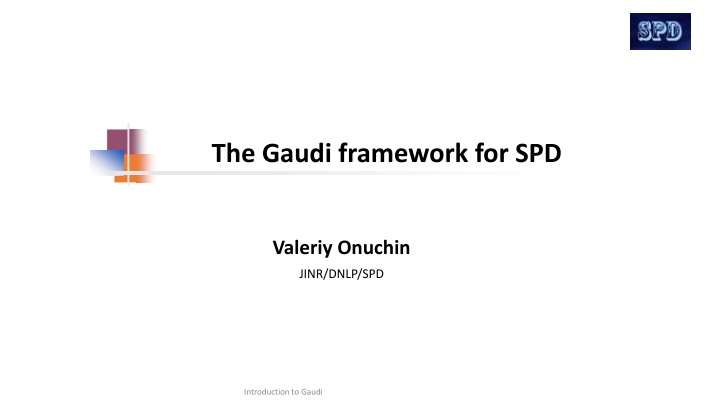The Gaudi Framework
The Gaudi framework is crucial for processing events, managing data objects, and accessing various components in a new format. It encompasses algorithms, event stores, services, and tools necessary for efficient data processing in scientific applications. The framework provides flexibility through configurable algorithms and demonstrates best practices for developing functional algorithms in the high-energy physics domain.
Download Presentation

Please find below an Image/Link to download the presentation.
The content on the website is provided AS IS for your information and personal use only. It may not be sold, licensed, or shared on other websites without obtaining consent from the author.If you encounter any issues during the download, it is possible that the publisher has removed the file from their server.
You are allowed to download the files provided on this website for personal or commercial use, subject to the condition that they are used lawfully. All files are the property of their respective owners.
The content on the website is provided AS IS for your information and personal use only. It may not be sold, licensed, or shared on other websites without obtaining consent from the author.
E N D
Presentation Transcript
The Gaudi framework for SPD Valeriy Onuchin JINR/DNLP/SPD Introduction to Gaudi
Adapted by : Adapted by : LHCb (CERN) ATLAS (CERN) FCC (CERN) EIC (BNL, USA) SCTau (BINP, Novosibirsk) BES III (IHEP, China)
What is the Gaudi framework? The Gaudi framework runs over a list of events, providing ways to process them and store data in a new format. It creates and manages Data Objects, which can hold a variety of data. A Transient Event Store (TES) stores data objects in a way to make them accessible to the rest of the framework, and parts of it can be made persistent in a ROOT format file. The data in the TES is created and accessed by Algorithms, which produce data objects and process data objects. Gaudi also provides Services, which provide access to other parts of the framework, such as histograms. Tools are lightweight routines that are also available. The Application Manager manages these components. The Application Manager manages these components. The Gaudi framework runs over a list of events, providing ways to process them and store data in a new format. It creates and manages Data Objects, which can hold a variety of data. A Transient Event Store (TES) stores data objects in a way to make them accessible to the rest of the framework, and parts of it can be made persistent in a ROOT format file. The data in the TES is created and accessed by Algorithms, which produce data objects and process data objects. Gaudi also provides Services, which provide access to other parts of the framework, such as histograms. Tools are lightweight routines that are also available. Algorithms This is the most important component of the framework for an user to know. Algorithms are called once per physics event, and (traditionally) implement three methods beyond constructor/destructor: initialize, execute, and finalize. Also, beginRun and endRun are available, though be careful not to misuse state. A set of Gaudi Algorithm Examples can be found at https://gitlab.cern.ch/gaudi/Gaudi/-/tree/master/GaudiExamples Very useful Gaudi Algorithms templates were developed by LHCb guys https://gitlab.cern.ch/lhcb/LHCbSkeleton They include Python scripts to create Gaudi Functional Algorithm C++ classes. Must be adapted to SPD!
Properties Algorithms are a Configurable, which means they can be accessed in Python and Properties can be manipulated there. In the classic API, a property is declared in the constructor, using: declareProperty("PropertyName", f_value, "Description of property"); Here, f_value is a reference to a variable for an int, string, etc. It is almost always a member variable for the class so that you can access it in the other methods. To use a property, you can simply access it on the configurable in Python: my_algorithm.PropertyName = 42 Another way to declare property is to define a member variable of type Gaudi::Property<>: Gaudi::Property<int> m_some_int{this, "SomeInt", 0, "Description of some int"};
Transient Event Store (TES) The TES is a place where you can store items on a per-event basis. It should be viewed as non-mutable; meaning that once you place an item in it, it should never change. Persistence is optional. The path to an event should always start with "/Event", though Gaudi is smart enough to assume that a path that does not start with a slash is a relative path, and will get "/Event/" prepended to it. In the classic framework, you used get and put functions to access the TES. For this you must use GaudiAlgorithm instead of Algorithm, which is a specialization to add access to the TES. You will need to add GaudiAlgLib to the linked library list for the GaudiAlgorithm. To place an item in the event store, create a pointer to a new object, and then put it in the event store in an execute method: auto data = new DataObject(); put(data, "/Event/SomeData"); The event store will take ownership of the object, so do not delete it. To retrieve it, also in an execute method: auto data = get<DataObject>("/Event/SomeData");
Gaudi Services The basic modules of the GAUDI framework and the connections between them are shown in the picture The Application manager (in code denoted as ApplicationMgr) controls the execution of the jobs within the framework. It creates and initializes the required modules in the system, and retrieves input data. The input data is a collection of highly-structured information that describe particle collisions (also called events) recorded inside the detectors or created in simulations. The Application manager loops over the input data events and executes the algorithms. The GAUDI services provide various utilities and services for the Algorithms in the system, which are also initialized by the Application manager at the beginning of a job. Normally, only one instance of a service is required in the job. There are a number of different services within the framework that can be used by the Algorithms but some of the main ones are: Event Data service (EventDataSvc) and Histogram service (HistogramDataSvc) that read and process individual events, Detector Data service (DetDataSvc) for capturing detector data, Message service (MessageSvc) logs progress or errors in the Algorithms and Tool Service (ToolSvc) manages Algorithm tools, which are required during the Algorithm execution. The Persistency services allow writing the output data on the disk. There are many other services in the framework that provide specialized functions that can be enabled and disabled by the users.
Gaudi Hive Gaudi Hive: multi-threaded, concurrent extension to Gaudi uses Intel TBB for thread management https://github.com/oneapi-src/oneTBB Data Flow driven Algorithms declare their data dependencies build a directed acyclic graph - can be used for optimal scheduling Scheduler automatically executes Algorithms as data becomes available. Multi-threaded Algorithms process events in their own thread, from a shared Thread Pool. Pipelining: multiple algorithms and events can be executed simultaneously some Algorithms are long, and produce data that many others need (eg track fitting). instead of waiting for it to finish, and idling processor, start a new event Algorithm Cloning multiple instances of the same Algorithm can exist, and be executed concurrently, each with different Event Context. cloning is not obligatory, balancing memory usage with concurrency. support for re-entrant Algorithms
Gaudi Hive Operation Configuration, Initialization, Finalization are performed serially in "master" thread only Algorithm::execute is concurrent Algorithms are scheduled when data becomes available Algorithms must declare their inputs at initialization or dynamically with DataHandles data only exchanged via whiteboard bb::task wraps the pair (Algorithm*, EventContext) Algorithms can be non-cloneable (singleton), cloneable, or re-entrant more clones = more memory, but greater opportunity for concurrency cardinality is tunable at runtime re-entrant is best, but hardest to code tbb layer is normally hidden from users, but Algorithms can explicitly use tbb constructs (parallel_for, concurrent_queue, etc) for finer grained parallelism plays well with the Scheduler Component model allows Scheduler to be replaced as needed
An example of full G4 simulation p.1 from Gaudi.Configuration import * from Constants import SystemOfUnits as units # Data service from Configurables import ScTauDataSvc decKey = 'gun_geantino' podioevent = ScTauDataSvc("EventDataSvc") from Configurables import ParticleGun from Configurables import GenAlg from Configurables import HepMCToEDMConverter from Configurables import HepMCFileWriter from Configurables import Gaudi__ParticlePropertySvc from PathResolver import PathResolver particlePropertySvc = Gaudi__ParticlePropertySvc("ParticlePropertySvc", ParticlePropertiesFile=PathResolver.FindDataFile('GenParticleData/ParticleTable.txt') ) from math import pi Momentum = 1500 Theta = pi / 2.0 Phi = pi / 2.0 dTheta = pi / 3.0 dPhi = pi / 12.0 guntool = ParticleGun("PdgCodes", PdgCodes=[480000000]) guntool.OutputLevel=DEBUG guntool.MomentumMin = Momentum * units.MeV guntool.MomentumMax = Momentum * units.MeV guntool.ThetaMin = (Theta - dTheta) * units.rad guntool.ThetaMax = (Theta + dTheta) * units.rad guntool.PhiMin = (Phi - dPhi) * units.rad guntool.ThetaMin = (Theta - dTheta) * units.rad guntool.PhiMax = (Phi + dPhi) * units.rad
An example of full G4 simulation p.2 gun = GenAlg("ParticleGun", SignalProvider=guntool) gun.hepmc.Path = "hepmc" writer = HepMCFileWriter("HepMCFileWriter") writer.hepmc.Path="hepmc" hepmc_converter = HepMCToEDMConverter("Converter") hepmc_converter.hepmc.Path="hepmc" hepmc_converter.genparticles.Path="allGenParticles" hepmc_converter.genvertices.Path="allGenVertices" # DD4hep geometry service # Parses the given xml file from Configurables import GeoSvc from DetBase.DetConfigurator import DetConfigurator detector_conf = DetConfigurator() detector_conf.activateSubsystems( [ 'ALL' ] ) detector_geo_input = detector_conf.getGeoConfiguration() print( 'detector_geo_input =',detector_geo_input ) geoservice = GeoSvc("GeoSvc", detectors=detector_geo_input, OutputLevel=INFO) # Geant4 service # giving the names of tools will initialize the tools of that type from Configurables import SimG4UserSteppingActionTool userStepAction = SimG4UserSteppingActionTool("ScanningAction") userStepAction.PrintInfo = True; userStepAction.G4Hits.Path = "trajectory" from Configurables import SimG4ConstantMagneticFieldTool
An example of full G4 simulation p.3 field = SimG4ConstantMagneticFieldTool("SimG4ConstantMagneticFieldTool", FieldOn=True, IntegratorStepper="ClassicalRK4", FieldComponentX=0.0*units.tesla, FieldComponentY=0.0*units.tesla, FieldComponentZ=1.0*units.tesla, FieldRMax=100.0*units.m, FieldZMax=100.0*units.m) from Configurables import SimG4EmptySDTool, SimG4SensitiveDetectorMasterTool sd_names = detector_conf.getSensDetName() SensDetectors = [] for sd_name in sd_names: EmptySD = SimG4EmptySDTool(sd_name) SensDetectors.append(EmptySD) SDMasterTool = SimG4SensitiveDetectorMasterTool("SDMasterTool", sensDetectors = SensDetectors) from Configurables import SimG4Alg, SimG4GeantinosFromEdmTool # next, create the G4 algorithm, giving the list of names of tools ("XX/YY") particle_converter = SimG4GeantinosFromEdmTool("EdmConverter") particle_converter.genParticles.Path = "allGenParticles" geantsim = SimG4Alg("SimG4Alg", eventProvider=particle_converter, detector='SimG4DD4hepDetector , physicslist="SimG4GeantinoDeposits", actions=[userStepAction], magneticField=field, SDMaster=SDMasterTool) # PODIO output algorithm from Configurables import PodioOutput out = PodioOutput("out", OutputLevel=INFO, filename = './'+ decKey + '_g4sim.root') out.outputCommands = ["drop allGenParticles"] # ApplicationMgr from Configurables import ApplicationMgr ApplicationMgr(TopAlg = [gun, writer, hepmc_converter, geantsim, out], EvtSel = 'NONE', EvtMax = 10, # order is important, as GeoSvc is needed by SimG4Svc ExtSvc = [particlePropertySvc, podioevent, geoservice], OutputLevel = INFO, AuditAlgorithms = True, AuditTools = True, AuditServices = True)
The Status of SPeeD developmnet The project is at the stage of prototyping and testing. Hopefully to be ready for public testing ASAP (before collaboration week) . The main code was stolen from SCtau Aurora framework (G4 Simulation part) Build system was stolen from LHCb Dependency: Gaudi ("/cvmfs/sft-nightlies.cern.ch/lcg/latest/Gaudi/master-4f9ac/x86_64-centos7-gcc10-opt") ROOT 6.24 Geant4 ("/cvmfs/sft-nightlies.cern.ch/lcg/latest/Geant4/11.0.2-b78b7/x86_64-centos7-gcc11-opt") DD4hep ("/cvmfs/sft-nightlies.cern.ch/lcg/latest/DD4hep/master-1c0dc/x86_64-centos7-gcc10-opt") EDM4hep ("/cvmfs/sft-nightlies.cern.ch/lcg/latest/EDM4hep/00.04.01-d9194/x86_64-centos7-gcc11-opt") Podio ("/cvmfs/sft-nightlies.cern.ch/lcg/latest/podio/00.14.01-642d4/x86_64-centos8-gcc10-opt") CLHEP ("/cvmfs/sft-nightlies.cern.ch/lcg/latest/clhep/2.4.5.1-ebe73/x86_64-centos9-gcc11-opt") HepMC3 ( /cvmfs/sft-nightlies.cern.ch/lcg/latest/hepmc3/HEAD-cfcd1/x86_64-centos7-gcc11-opt ) All externals are precompiled. PATH, LD_LIBRARARY_PATH, ROOT_INCLUDE_PATH, PYTHONPATH are hardcoded. Pythia8 generator from https://github.com/HEP-FCC/k4Gen will be added ASAP
References Repos & Docs: https://gitlab.cern.ch/gaudi/Gaudi https://gitlab.cern.ch/lhcb/Gaudi https://gitlab.cern.ch/gaudi/Gaudi/tree/master/GaudiExamples https://github.com/HEP-FCC/FCCSW https://gaudi-framework.readthedocs.io/en/latest/index.html Gaudi Workshop 2016 (https://indico.cern.ch/event/556551/) LHCb Gaudi docs (https://lhcb.github.io/developkit-lessons/first-development-steps/02b-gaudi-intro.html) Code template for the gaudi functional algorithm (https://gitlab.cern.ch/lhcb/LHCbSkeleton) SCtau Wiki: https://ctd.inp.nsk.su/wiki/index.php/Simple_SCT_parametric_simulation https://ctd.inp.nsk.su/wiki/index.php/Use_Analysis_package























